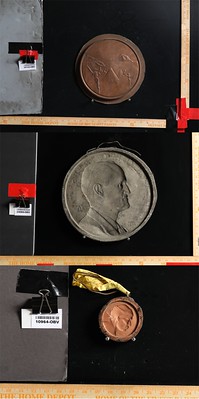
PREV ARTICLE
NEXT ARTICLE
FULL ISSUE
PREV FULL ISSUE
MOVING THE MEDALLIC ART COMPANY ARCHIVESI don't believe we've published this before - back in April Dr. Jesse Kraft of the American Numismatic Society published an ANS Pocket Change blog about the laborious move of the Medallic Art Company archives, purchased by the Society in 2018. Here's an excerpt, but be sure to see the complete article online. -Editor As many of you know, the American Numismatic Society purchased the archives of the Medallic Art Company (MACO) at a bankruptcy auction in 2018. The sheer size of this purchase, however, did not allow for the tale to end so quickly. Within weeks of the landmark purchase, components of the collection were shipped to various corners of the country. The medals and paper archives from MACO moved to the ANS headquarters in New York City; the dies and hubs were transferred to Medalcraft Mint, Inc., in Wisconsin, who is generously storing them for the ANS at the moment; and the galvanos, die shells, and plasters took a short drive to Mound House, Nevada, less than five miles from Dayton—where MACO last operated. By early 2020, with a good portion of the medals catalogued, the ANS began to think about the parts of the collection that remained out of reach. While we were headlong into making plans, however, the COVID-19 pandemic altered reality for most people and put a halt to everything that we hoped would happen. Along with the rest of the world, the ANS heeded to CDC guidelines, masked up, and waited for life to find some semblance of normalcy. The time has come, however, for the next chapter in the MACO saga to begin! With the third and most recent wave behind us, vaccines becoming more-readily available, and infection rates dropping by the day, the ANS is in the planning stages to transfer all of the galvanos, die shells, and plasters from Mound House to Manhattan. Unlike the galvanos that many numismatists are already familiar with, these were not meant to be sold to interested buyers, but are all production galvanos, made for the sole purpose of creating dies to strike medals. Nearly the entire run of MACO products is represented in production-galvano format. To put quantity of this portion of the collection into perspective, just the material in Mound House equates to about 17,000 objects that are stored in roughly 1,400 boxes, which are situated on about 90 pallets and will likely take four (4) tractor trailers to completely move across the country. Given the size, these early stages have been no easy undertaking and involved three major tasks: organizing what we know exist to efficiently absorb the collection as it arrives, finding a location to store the material, and locating a long-haul trucking company. The first step in the process was to organize the pieces that we have records for. To do this, I had nothing else but to rely on more than 20,000 photographs that were taken as the collection was packed up in 2018. At the time, knowing that this would likely be the last that any of this material would be seen for at least a few years, the ANS hired Lou Manna Photography, of Reno, Nevada, to image as many as he could.
This last group is among the most important groups of Native American ethnographic renderings in any medium, perhaps second only to the paintings by George Catlin in the 1830s. While many of the MACO galvanos are of extreme importance or artistic mastery, these truly are priceless American artifacts.
To read the complete article, see:
Wayne Homren, Editor The Numismatic Bibliomania Society is a non-profit organization promoting numismatic literature. See our web site at coinbooks.org. To submit items for publication in The E-Sylum, write to the Editor at this address: whomren@gmail.com To subscribe go to: https://my.binhost.com/lists/listinfo/esylum All Rights Reserved. NBS Home Page Contact the NBS webmaster 
|


